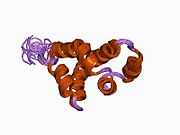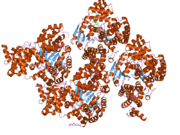APAF1
Apoptotic protease activating factor 1, also known as APAF1, is a human homolog of C. elegans CED-4 gene.[2][3][4] APAF-1 and CED-4 homologs have been found in all currently sequenced animal genomes.
Function
This gene encodes a cytoplasmic protein that forms one of the central hubs in the apoptosis regulatory network. This protein contains (from the N terminal) a caspase recruitment domain (CARD), an ATPase domain (NB-ARC), few short helical domains and then several copies of the WD40 repeat domain. Upon binding cytochrome c and dATP, this protein forms an oligomeric apoptosome. The apoptosome binds and cleaves Procaspase 9 protein, releasing its mature, activated form. The precise mechanism for this reaction is still debated though work published by Guy Salvesen suggests that the apoptosome may induce caspase 9 dimerization and subsequent autocatalysis.[5] Activated caspase 9 stimulates the subsequent caspase cascade that commits the cell to apoptosis.
Alternative splicing results in several transcript variants encoding different isoforms.[2]
Structure
The first crystal structure of the first two (CARD and NB-ARC) domains of the Apaf-1 protein PDB 1z6t was solved in the laboratory of Yigong Shi.[6] It contains a CARD domain with a Greek key motif composed of six helices, a Rossman fold nucleotide binding domains, a short helical motif and a winged-helix domain.
Discovery
The Apaf-1 protein was identified by Xiaodong Wang.[3]
Interactions
APAF1 has been shown to interact with NLRP1,[7] Caspase-9,[7][8][9][10][11] APIP,[8] BCL2-like 1[10][11] and HSPA4.[12]
References
- ↑ PDB 2p1h; Milam SL, Nicely NI, Feeney B, Mattos C, Clark AC (May 2007). "Rapid folding and unfolding of Apaf-1 CARD". J. Mol. Biol. 369 (1): 290–304. doi:10.1016/j.jmb.2007.02.105. PMC 2020445. PMID 17408690.
- ↑ 2.0 2.1 "Entrez Gene: APAF1 apoptotic peptidase activating factor 1".
- ↑ 3.0 3.1 Zou H, Henzel WJ, Liu X, Lutschg A, Wang X (August 1997). "Apaf-1, a human protein homologous to C. elegans CED-4, participates in cytochrome c-dependent activation of caspase-3". Cell 90 (3): 405–13. doi:10.1016/S0092-8674(00)80501-2. PMID 9267021.
- ↑ Kim H, Jung YK, Kwon YK, Park SH (1999). "Assignment of apoptotic protease activating factor-1 gene (APAF1) to human chromosome band 12q23 by fluorescence in situ hybridization". Cytogenet. Cell Genet. 87 (3-4): 252–3. doi:10.1159/000015436. PMID 10702682.
- ↑ Pop C, Timmer J, Sperandio S, Salvesen GS (April 2006). "The apoptosome activates caspase-9 by dimerization". Mol. Cell 22 (2): 269–75. doi:10.1016/j.molcel.2006.03.009. PMID 16630894.
- ↑ Riedl SJ, Li W, Chao Y, Schwarzenbacher R, Shi Y (April 2005). "Structure of the apoptotic protease-activating factor 1 bound to ADP". Nature 434 (7035): 926–33. doi:10.1038/nature03465. PMID 15829969.
- ↑ 7.0 7.1 Chu, Z L; Pio F; Xie Z; Welsh K; Krajewska M; Krajewski S; Godzik A; Reed J C (March 2001). "A novel enhancer of the Apaf1 apoptosome involved in cytochrome c-dependent caspase activation and apoptosis". J. Biol. Chem. (United States) 276 (12): 9239–45. doi:10.1074/jbc.M006309200. ISSN 0021-9258. PMID 11113115.
- ↑ 8.0 8.1 Cho, Dong-Hyung; Hong Yeon-Mi; Lee Ho-June; Woo Ha-Na; Pyo Jong-Ok; Mak Tak W; Jung Yong-Keun (September 2004). "Induced inhibition of ischemic/hypoxic injury by APIP, a novel Apaf-1-interacting protein". J. Biol. Chem. (United States) 279 (38): 39942–50. doi:10.1074/jbc.M405747200. ISSN 0021-9258. PMID 15262985.
- ↑ Li, P; Nijhawan D; Budihardjo I; Srinivasula S M; Ahmad M; Alnemri E S; Wang X (November 1997). "Cytochrome c and dATP-dependent formation of Apaf-1/caspase-9 complex initiates an apoptotic protease cascade". Cell (UNITED STATES) 91 (4): 479–89. doi:10.1016/S0092-8674(00)80434-1. ISSN 0092-8674. PMID 9390557.
- ↑ 10.0 10.1 Hu, Y; Benedict M A; Wu D; Inohara N; Núñez G (April 1998). "Bcl-XL interacts with Apaf-1 and inhibits Apaf-1-dependent caspase-9 activation". Proc. Natl. Acad. Sci. U.S.A. (UNITED STATES) 95 (8): 4386–91. doi:10.1073/pnas.95.8.4386. ISSN 0027-8424. PMC 22498. PMID 9539746.
- ↑ 11.0 11.1 Pan, G; O'Rourke K; Dixit V M (March 1998). "Caspase-9, Bcl-XL, and Apaf-1 form a ternary complex". J. Biol. Chem. (UNITED STATES) 273 (10): 5841–5. doi:10.1074/jbc.273.10.5841. ISSN 0021-9258. PMID 9488720.
- ↑ Saleh, A; Srinivasula S M; Balkir L; Robbins P D; Alnemri E S (August 2000). "Negative regulation of the Apaf-1 apoptosome by Hsp70". Nat. Cell Biol. (ENGLAND) 2 (8): 476–83. doi:10.1038/35019510. ISSN 1465-7392. PMID 10934467.
Further reading
- Smith TF, Gaitatzes C, Saxena K, Neer EJ (1999). "The WD repeat: a common architecture for diverse functions.". Trends Biochem. Sci. 24 (5): 181–5. doi:10.1016/S0968-0004(99)01384-5. PMID 10322433.
- van Oirschot JT (1999). "Diva vaccines that reduce virus transmission.". J. Biotechnol. 73 (2-3): 195–205. doi:10.1016/S0168-1656(99)00121-2. PMID 10486928.
- Nakajima D, Okazaki N, Yamakawa H et al. (2003). "Construction of expression-ready cDNA clones for KIAA genes: manual curation of 330 KIAA cDNA clones.". DNA Res. 9 (3): 99–106. doi:10.1093/dnares/9.3.99. PMID 12168954.
- Campioni M, Santini D, Tonini G et al. (2006). "Role of Apaf-1, a key regulator of apoptosis, in melanoma progression and chemoresistance.". Exp. Dermatol. 14 (11): 811–8. doi:10.1111/j.1600-0625.2005.00360.x. PMID 16232302.
- Zou H, Henzel WJ, Liu X et al. (1997). "Apaf-1, a human protein homologous to C. elegans CED-4, participates in cytochrome c-dependent activation of caspase-3.". Cell 90 (3): 405–13. doi:10.1016/S0092-8674(00)80501-2. PMID 9267021.
- Li P, Nijhawan D, Budihardjo I et al. (1997). "Cytochrome c and dATP-dependent formation of Apaf-1/caspase-9 complex initiates an apoptotic protease cascade.". Cell 91 (4): 479–89. doi:10.1016/S0092-8674(00)80434-1. PMID 9390557.
- Ishikawa K, Nagase T, Nakajima D et al. (1998). "Prediction of the coding sequences of unidentified human genes. VIII. 78 new cDNA clones from brain which code for large proteins in vitro.". DNA Res. 4 (5): 307–13. doi:10.1093/dnares/4.5.307. PMID 9455477.
- Pan G, O'Rourke K, Dixit VM (1998). "Caspase-9, Bcl-XL, and Apaf-1 form a ternary complex.". J. Biol. Chem. 273 (10): 5841–5. doi:10.1074/jbc.273.10.5841. PMID 9488720.
- Hu Y, Benedict MA, Wu D et al. (1998). "Bcl-XL interacts with Apaf-1 and inhibits Apaf-1-dependent caspase-9 activation.". Proc. Natl. Acad. Sci. U.S.A. 95 (8): 4386–91. doi:10.1073/pnas.95.8.4386. PMC 22498. PMID 9539746.
- Srinivasula SM, Ahmad M, Fernandes-Alnemri T, Alnemri ES (1998). "Autoactivation of procaspase-9 by Apaf-1-mediated oligomerization.". Mol. Cell 1 (7): 949–57. doi:10.1016/S1097-2765(00)80095-7. PMID 9651578.
- Cecconi F, Alvarez-Bolado G, Meyer BI et al. (1998). "Apaf1 (CED-4 homolog) regulates programmed cell death in mammalian development.". Cell 94 (6): 727–37. doi:10.1016/S0092-8674(00)81732-8. PMID 9753320.
- Inohara N, Gourley TS, Carrio R et al. (1999). "Diva, a Bcl-2 homologue that binds directly to Apaf-1 and induces BH3-independent cell death.". J. Biol. Chem. 273 (49): 32479–86. doi:10.1074/jbc.273.49.32479. PMID 9829980.
- Hu Y, Ding L, Spencer DM, Núñez G (1999). "WD-40 repeat region regulates Apaf-1 self-association and procaspase-9 activation.". J. Biol. Chem. 273 (50): 33489–94. doi:10.1074/jbc.273.50.33489. PMID 9837928.
- Song Q, Kuang Y, Dixit VM, Vincenz C (1999). "Boo, a novel negative regulator of cell death, interacts with Apaf-1.". EMBO J. 18 (1): 167–78. doi:10.1093/emboj/18.1.167. PMC 1171112. PMID 9878060.
- Slee EA, Harte MT, Kluck RM et al. (1999). "Ordering the cytochrome c-initiated caspase cascade: hierarchical activation of caspases-2, -3, -6, -7, -8, and -10 in a caspase-9-dependent manner.". J. Cell Biol. 144 (2): 281–92. doi:10.1083/jcb.144.2.281. PMC 2132895. PMID 9922454.
- Zou H, Li Y, Liu X, Wang X (1999). "An APAF-1.cytochrome c multimeric complex is a functional apoptosome that activates procaspase-9.". J. Biol. Chem. 274 (17): 11549–56. doi:10.1074/jbc.274.17.11549. PMID 10206961.
- Saleh A, Srinivasula SM, Acharya S et al. (1999). "Cytochrome c and dATP-mediated oligomerization of Apaf-1 is a prerequisite for procaspase-9 activation.". J. Biol. Chem. 274 (25): 17941–5. doi:10.1074/jbc.274.25.17941. PMID 10364241.
- Qin H, Srinivasula SM, Wu G et al. (1999). "Structural basis of procaspase-9 recruitment by the apoptotic protease-activating factor 1.". Nature 399 (6736): 549–57. doi:10.1038/21124. PMID 10376594.
- Drosopoulos NE, Walsh FS, Doherty P (1999). "A soluble version of the receptor-like protein tyrosine phosphatase kappa stimulates neurite outgrowth via a Grb2/MEK1-dependent signaling cascade.". Mol. Cell. Neurosci. 13 (6): 441–9. doi:10.1006/mcne.1999.0758. PMID 10383829.
| |||||||||||||||||||||









